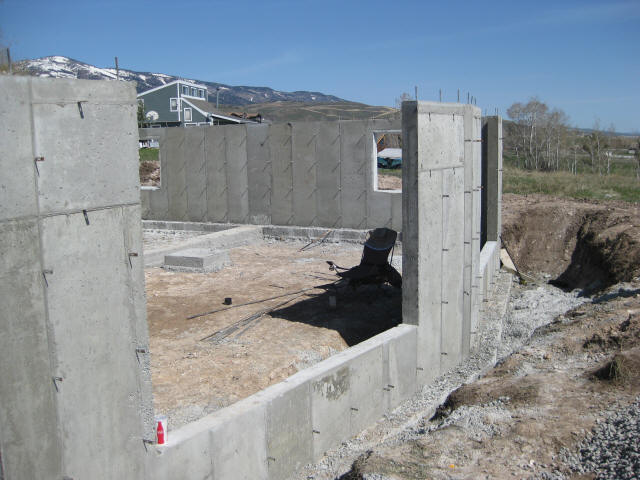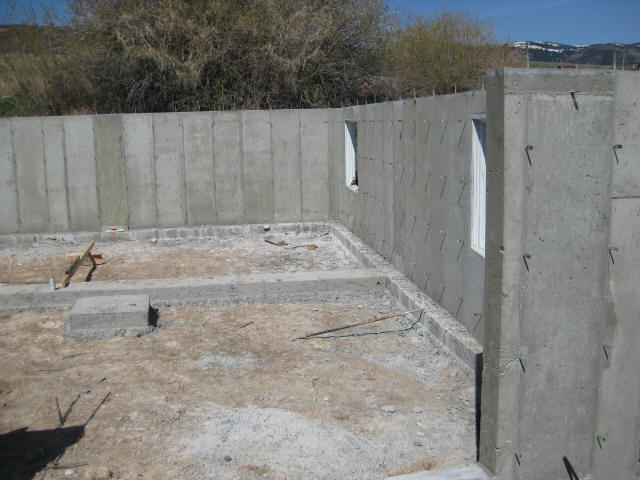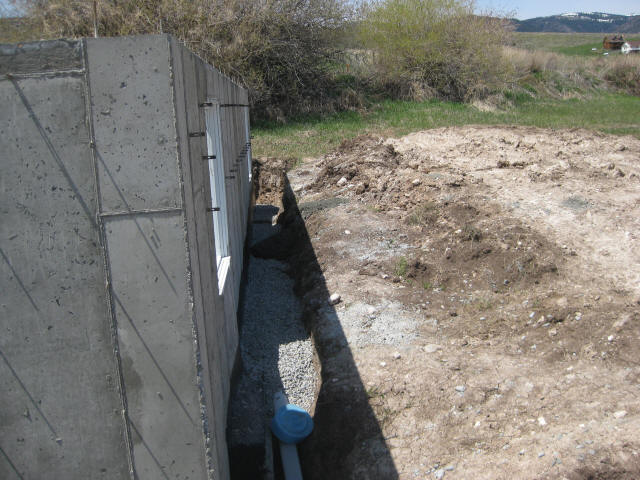Concrete Foundation
Foundation walls can be built using concrete block, Insulated Concrete Forms (ICFs), or most commonly poured concrete. With a crew of helpers to move blocks and mix mortar, an experienced block mason can erect a simple crawl space foundation wall in just a couple days. However, in many parts of the country, poured concrete foundations have surpassed concrete block walls in popularity. Concrete foundation subcontractors can be hired to form and pour concrete walls and that's exactly what we did on our cabin. If a concrete foundation contractor arrives in the morning with a truckload of wall forms and rebar, he will probably have everything erected before the end of the day. Don't forget to have the forms inspected before the concrete truck arrives to fill them with concrete.
Concrete foundation forms are usually stripped a day or two after the pour. It takes about a week for concrete to get its first hard set, but you can begin to lay out and install the sills as soon as the forms come off. Even though you may not be forming and pouring the walls yourself, it's useful to know about some aspects of the process. This applies to whether you're building foundation walls with concrete block or with insulated concrete forms.
The concrete foundation work was one of the few items we hired out on our cabin project. Since we didn't have access to the forms and other equipment for pouring forms we elected to have someone else do the work. We had the sub bill the concrete to us directly and we provided the window bucks for the concrete foundation. Here's some pictures of the final product since we were not around to see it actually take place.
Concrete Foundation Insulation
Concrete foundation insulation isn't used in mild climates. In areas with frigid winter months it can improve interior comfort and save on heating costs. Even though it's not required by code in many areas, it's definitely worth installing wherever prolonged freezing temperatures are expected. You can install insulation on the inside or outside of a crawl space or basement wall. Exterior insulation, in the form of rigid foam boards, is glued to the foundation walls before backfilling. Where they're exposed above the finished grade on the exterior, insulation boards must be protected with siding material or stucco. It's important to remember that any type of foundation insulation can provide a hidden passageway for termites and other insects to enter the house. Make sure you cut off this passageway by installing a termite shield beneath the sill. The picture below shows an example of rigid foam insulation installed on the exterior of the concrete foundation wall.

Concrete Foundation for Cabin
The concrete foundation work was one of the few items we hired out. Since we didn't have access to the forms and other equipment for pouring forms we elected to have someone else do the work. We had the sub bill the concrete to us directly and we provided the window bucks for the foundation. Here's some pictures of the final product since we were not around to see it actually take place.

The concrete foundation is 8' tall and 8" thick except for the drop-down in the front were the foundation is 10' tall.
Foundation Anchor Bolts and Tie-Downs
Regardless of the type of foundation, anchor bolts are required around the perimeter to hold the sill plates and the walls securely in place. The picture below shows these bolts inserted in the top of the concrete foundation. In earthquake and hurricane zones, the building code may call for additional hold-downs, such as metal straps (a.k.a. hurricane straps) that are embedded or bolted to the foundation and extended to the sills, rim joists, and wall framing. Most codes require that a long piece of rebar be planted in the concrete near the planned location of the main electrical panel so that it can be used as a ground for the electrical system. The is known as an ufer ground (see footing section which shows the ufer ground tied into the footing rebar).

Concrete Foundation Coatings
It's important to keep moisture out of your basement or crawl space area, as well as out of the masonry wall itself. Foundation coatings help accomplish this. Concrete block walls are often parged (covered with a layer of mortar that conceals and protects the joints between the blocks). A waterproof coating should also be applied. Asphalt-type coatings are popular because they are inexpensive and have been used for many years. More effective and expensive coatings are also available and should be considered when you're building in soil that stays wet for extended periods of time. No matter how good a waterproof coating is supposed to be, it shouldn't be your only line of defense against under-house moisture.
For our cabin foundation, we picked up some foundation tar at Home Depot and rolled a thick layer on the concrete foundation that would be below grade. See picture below.

Backfill around the Concrete Foundation
The foundation is ready for the floor framing work to begin but the job site isn't. Backfilling against the walls restores at least of the site's original contour, making it safer and easier to move around. If you're building a house with a full basement, the backfilling process is sometimes delayed until after the first floor is framed and sheathed because they are taller and basement walls need the extra rigidity provided by the floor framing to ensure that backfilling doesn't damage the foundation. The isn't a major concern with crawl spaces.
Ensuring Proper Foundation Drainage
Follow the guidelines below and you'll stand a pretty good chance of keeping water on the outside of your foundation:
- Don't build on the lowest part of the lot
- Seal all holes around the pipes that go through the concrete
- Install perforated drainpipes at the bottom of the concrete footings around the outside of the foundation
- Coat the foundation walls with a suitable damp-proofing or water-proofing treatment. Check with builders in your area or the local building department to find out which foundation coatings are recommended. Tar coatings are inexpensive but not as effective as more recently developed waterproofing treatments.
- Compact loose fill as you backfill around the foundation, but be careful, because excessive compaction can damage masonry walls. Make sure the finish grade (ground level) slopes away from the foundation. Remember that loose fill can settle. A finished grade that slopes away from the house may later slope toward the house should settling occur.
- Use gutters and downspouts to manage high roof water runoff. Make sure you keep gutters unclogged and install downspouts to direct water away from the house.
Cabin Foundation Drain
We put a foundation drain around the perimeter of the cabin to take care of any drainage problems that might exist. We followed the advice on ensuring proper drainage given the fact we had a major irrigation canal running directly behind our lot not more that 40ft from our cabin. We used 4" perforated black drain pipe for this drain. We also picked up a stretchable sock made just for this application that goes over the drain pipe to prevent sediment and debris from getting into the drain. Luckily we had just enough slope on our lot to run the ends of the drain to the end of the lot and be OK. Without this, we would have needed to run to a sump pump.

Back to top - Concrete Foundation
